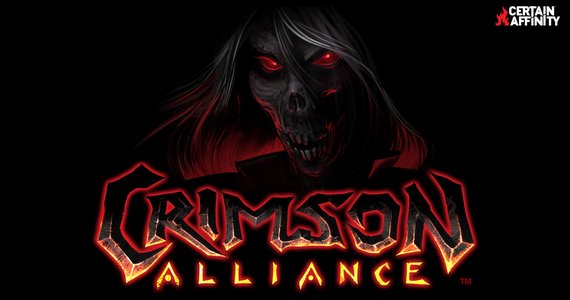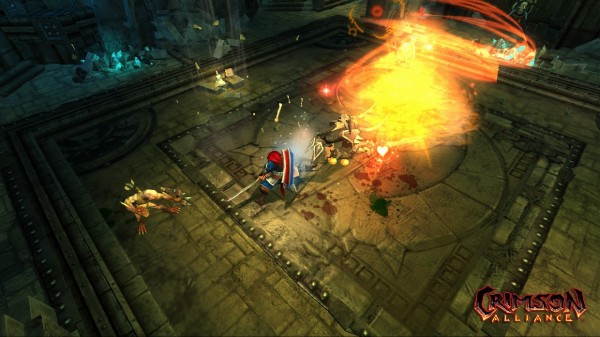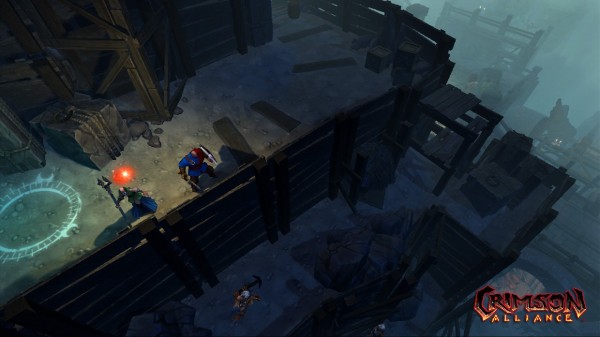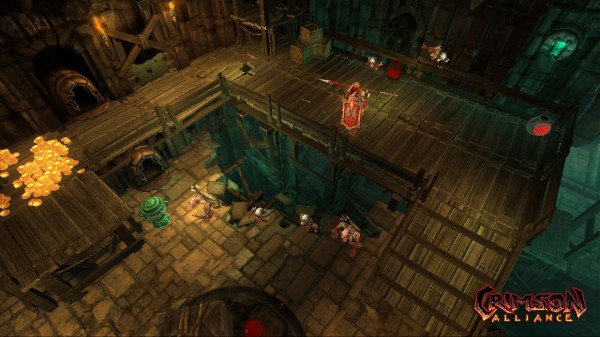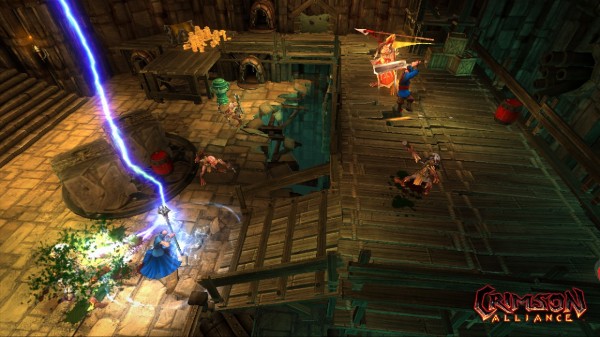Crimson Alliance review (XBLA)
Crimson Alliance was developed by Certain Affinity and published by Microsoft Studios. It was released on September 7, 2011. The game is a free download, but characters must be purchased. One character costs 800 MSP, while all three can be purchased for 1200 MSP. A copy of the game was provided for review purposes.
Isometric cameras come with a whole myriad of expectations and memories for many gamers. Most jump straight to Gauntlet, the quintessential isometric beat stuff up game. Well Crimson Alliance is no Gauntlet. Granted, those enjoying the first minutes of their virgin voyage into this game will call blasphemy, but by the end of the first level the differences will be very clear. Crimson Alliance can, however, play like Gauntlet if allowed to, but it would take a lot of effort to ignore the awesome aspects of Crimson Alliance that make it such a different game.
Crimson Alliance has a slight flair for the retro in that it is very, very much about score. There is a story, and there are characters, but the real meat is in the mechanics; Crimson Alliance thrives on good gameplay. The game has three classes, Direwolf the Wizard, Moonshade the Assassin, and Gnox the Mercenary. Each class has its role, especially when it comes to co-op, but each has its offensive and defensive capabilities, none of them rely on each other necessarily, though they can assist each other. Each class’s ability to deal with the decent variety of enemies in Crimson Alliance varies greatly, so the game will play very differently based on which class is being used, and which skills of the class are being focused on. While it’s an action-RPG, Crimson Alliance isn’t so RPG-heavy, the stats are simple and easy to manage as they’re based off of the equipment and there aren’t too many permutations of skills. It’s easy to jump into, it’s easy to understand, but mastery is a different story. Living through a level of Crimson Alliance is pretty easy for the most part, but the multiplier mechanic used to get awesome scores is what really sends this game above and beyond. Every kill, every combo, every streak adds to the multiplier, but one hit, just one, will send the multiplier down one whole notch (it maxes out at 8). That whole mechanic is what Crimson Alliance hinges on and is why people that love to top leaderboards will be all over this game.
Here’s what we liked:
Crimson co-op – Having three classes rather than four in a four player coop game is a little strange, yes, but for the most part the coop is exponentially more enjoyable and satisfying than soloing. Each class works with the other in one fashion or another, and each class can make up for one’s weaknesses. On top of that, mowing down enemies with a full group of butt-kickers is incredibly satisfying and provides a decent challenge thanks to the game’s many difficulty levels. On top of that, there’s more opportunities for coordination when approaching an encounter, allowing for deep thought-out plans pinpointing high-threat targets and managing fodder.
Crimson chaos – The chaos in Crimson Alliance is very different from that of games like Torchlight as each and every encounter is scripted and enemies have no random traits, and the classes can know what to expect regarding their potency of their own abilities; Crimson Alliance might not surprise you very often. However, it will throw out mobs of fodder, difficult enemies, compounded effects and variable threats to keep players off balance. While each individual bit of chaos can eventually be mastered, it’s far more difficult and requires more variation and attention than simply smashing the attack button or one single skill. Some encounters can be solved that way, but for the most part the best crowd control skills won’t save your life without being meshed with some powerful attacks as well, and the strongest offense won’t yield a high score without a strong defense. Killing things isn’t all that’s required when looking to climb the leaderboards.
Crimson classes – There are only three classes for Crimson Alliance, but they don’t share much, consequentially playing through the game with each of the three will be a very different experience. Each has something about them making them unique, something to create strengths and weaknesses for each class, for instance the Wizard is the only one who can teleport and block while attacking, making him a very potent solo-er, however his fireballs don’t stop enemies from attacking, unlike the Mercenary and Assassin whose melee attacks stop enemies from attacking them. On that note, in fact, the Mercenary as a melee-only character is still incredibly potent, but has difficult crossing large rooms without playing it more defensive. The Mercenary can thin herds like no other, possessing the only melee which hits multiple enemies. The Assassin is a jack of all trades and master of none, possessing a lightning fast melee and a backstab as well as an equally quick dagger throw and a stun with the greatest range of all three classes.
Multiply this – The multiplier mechanic in Crimson Alliance is fantastic. It leads to some frustrations, but they’re not the game’s fault, the multiplier is all about player skill and preparation. The basics involve killing things to increase the multiplier, where getting hit means it drops an entire level. Finding the path to not taking damage while also dealing with the encounter as quick as possible is the meat of this game, and it’s incredibly satisfying. On top of that is working the sprees, killing many enemies in rapid succession will greatly increase score and multiplier (double kill, triple kill, etc.). While some classes are better at it than others while playing solo, every class has a way to deal with every situation and get tons of multiplier out of it, keeping the mechanic just as useful and entertaining for everyone.
Here’s what we didn’t like:
Controller throwing – This isn’t the worst thing ever, but there are times when this game can induce severe rage-fits. Another staffer of ours might say it’s up to “baby puncher” on the frustration level at times. To get the highest score means playing on Ridonkulus difficulty, and that means a lot of health for enemies, so fodder turns from, well, fodder, to pervasive irritation bent on poking away at the muliplier. While this isn’t necessarily the game’s fault, and indeed can be completely avoided by not trying to play Ridonkulus solo (or at all), the admonishment is necessary, things will happen that will be annoying, and the “minor things” listed below are all the more irritating when playing on the highest difficulty.
Short journey – Crimson Alliance‘s story is pretty… who cares-y. Perhaps it’s the way it’s told, or the fact that there aren’t any narrative elements within each level (the story is only told during cutscenes before certain levels), or the fact that the same stills (while they are well done) are reused several times. In fact, that shot zooming in on Direwolf’s eye can be haunting if watched too many times before going to sleep. Either way, the end of it all comes to soon, with only three major environments, two of which are pretty hackneyed (massive crystal mine sound familiar to anyone?), one of which (the desert) is by far a favorite and the most interesting, the game’s length is no illusion. Score-hounds will play this game to death, so will people that enjoy coop, but unlike other action-RPGs a single playthrough isn’t all that long, and there’s not much tying the player to the game other than the gameplay.
Minor things – There are some kinks and speedbumps in Crimson Alliance which detract in a small fashion from the overall experience but don’t break the game in the slightest. Taking large hits, usually from elites, don’t result in any invincibility at all, but they do result in canned animations, so if a character is hit down a hall of smaller enemies they’ll get hit each time, suffering far more than the initial blow’s worth in damage. The game is shared screen when playing coop, and while players can be off the screen for a short period of time, eventually one player will be teleported, or perhaps all of them, to another player, which are teleported and when or if they’re protected when this happens is unclear and inconsistent, but it’s irritating. While the teleportation can be be avoided, it’s a lot more irritating than simply being stuck not being able to move the screen. Lastly, when in the store with four players it quickly becomes difficult to see what’s available due to all the inventory screens blocking the way. Not sure what could’ve been done about that, perhaps making a more traditional (and admittedly boring) menu interface may have helped, but it makes trips to the store take longer than would be desired.
Crimson Alliance would love to be for everybody, and it certainly tries, but it’s not. There’s a lot to love here, especially when cooperating, but there is pretty serious punishment for simply going through the game, taking hits and not paying enough attention. However, it’s too much fun to simply be a try it, especially due to the variable pricing which allows people to simply buy the game with one character for 800 MSP. And so there’s a bit of an asterisk, this is a game that people who love action RPGs, cooperative games, or are scores-whores, will absolutely love and find a pleasant surprise in the way the gameplay is changed up from traditional action RPG formulas. However, Crimson Alliance likely won’t appeal to many outside of that realm, it’s certainly not a game one can simple waltz through and spam attacks and expect to succeed or have fun, and it’s not the deepest, most complex game when it comes to stats or loot, so it does have its audience, but its audience will love it. Take the score with a bit of an asterisk.
Score: Buy It!

